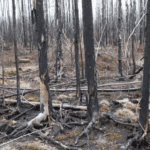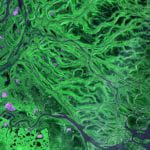The forest is burning more often, for a longer season, and in greater area, according to a new study published in the Canadian Journal of Forest Research.
“The amount of area burned and the number of large fires has increased significantly over the years,” said Chelene Hanes, lead author of the paper and a scientist with the fire and climate change group at the Great Lakes Forestry Centre.
The study compiled fire data from the last half century to determine if the data supported any predictions or significant trends when it comes to forest fires in Canada.
And it did—mostly.
Many of the predictions were correct, such as there being more fires on the landscape, a larger area burned, and a longer fire season. Compared with 57 years ago, the fire season is starting approximately one week earlier and ending one week later.
“What did surprise us were indications that human caused fires are decreasing,” said Hanes. Hanes also said that they aren’t certain why human caused fires are going down, but it could be due to increased efforts in fire suppression as well as education. Manmade fires only make up 10% of total area burned and have declined in frequency by 50% since 1980.
By comparison, lightning caused fires are increasing, particularly in western Canada.
“In terms of lightning caused fires, we do try to suppress, but they tend to happen in areas further away from communities, so it’s hard. And you can get lots of ignitions at once,” said Hanes.
Approximately 2 million hectares, an area roughly the size of Israel, of forest are burned annually in Canada.
Yearly expenditures for fire protection have ranged between $500 million to $1 billion, according to the Canadian government. Since 1970, forest fire expenditures across Canada have increased by $120 million per decade. The federal government estimates that to maintain the current level of fire protection until 2040, Canada would need to double forest fire spending. At $9 billion, the Fort McMurray wildfire of 2016 was the costliest disaster in modern Canadian history.
While the paper suggests that the amount of area burned will continue to increase, Hanes noted it will eventually plateau. “It can’t keep going up forever. Eventually, you need fuel. That’s one of the things people are putting forth is that we need more fire on the landscape in order to stop these really large fires.”
The study noted that one region in Canada burns particularly often. “A lot of large fires in Canada occur in the boreal forest. Those are large crown fires,” said Hanes. Canada’s boreal forest is mostly north of the 50th parallel and covers almost 60% of the country’s land mass.
However, that could shift with climate change.
Some studies suggest regions of burned boreal forest may be converted to be more temperate, as coniferous trees are replaced by deciduous trees that don’t burn as frequently. “That could limit the amount of area burned in the future,” said Hanes.
The paper also noted that some areas of Canada, such as parts of Ontario and Quebec have seen a decrease in both fires and area burned, particularly in populous areas.The study suggested that the increase in fires and size may be due to more fuel and hotter and drier weather, but Hanes said there is still research lacking when it comes to predicting fires. “We haven’t looked directly at the climatic drivers. It would be good to look at the connections with climate and how that could be affecting that.”
Hanes’ future research will focus on the influences of drought on spring fires and comparing fire seasons between Alberta and Ontario. She hopes her research will help improve predicting the start of fire seasons as well as give insights on forest fire severity.
Read the full study: Fire regime changes in Canada over the last half century in the Canadian Journal of Forest Research.




